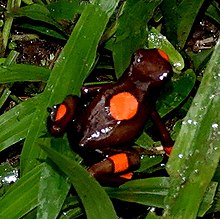| Harlequin poison frog | |
|---|---|

| |
| Conservation status | |
 Critically Endangered (IUCN 3.1) | |
| Scientific classification | |
| Domain: | Eukaryota |
| Kingdom: | Animalia |
| Phylum: | Chordata |
| Class: | Amphibia |
| Order: | Anura |
| Family: | Dendrobatidae |
| Genus: | Oophaga |
| Species: | O. histrionica |
| Binomial name | |
| Oophaga histrionica (Berthold, 1845) | |
| Synonyms | |
|
Dendrobates histrionicus Berthold, 1845 | |
The harlequin poison frog, also known as harlequin poison-dart frog (Oophaga histrionica), is a species of poison dart frog endemic to the Chocó region of western Colombia. The frog is normally found on the ground of tropical rain forests, among fallen limbs or leaf litter. Some frogs traditionally classified as Oophaga histrionica were separated as new species in 2018. These are Oophaga anchicayensis, Oophaga andresi and Oophaga solanensis.
Description
The harlequin poison frog has an average snout–vent length of 32.9 millimetres (1.30 in). The background coloration varies from light to dark brown, and there is usually a vivid spot on the dorsum.
Life history
The harlequin poison frog lives on the forest floor. The male calls from a low perch to advertise his presence. The male and female frog call to each other and touch each other before the female lays eggs among the leaf litter. When the eggs hatch, a parent transports the newly hatched tadpoles to a tiny water reservoir (often in the axil of a bromeliad). The mother returns periodically and lays unfertilized eggs, on which the tadpoles feed until ready to metamorphose and exit the water. The larva is an obligate egg-feeder and will starve without this form of nutrition. Adults feed on ants and mites on the ground after sunrise but not later than 16:00, when they are finding refuge either on the ground under leaf litter or elevated on fallen logs.
This rearing behavior makes harlequins among the most difficult poison dart frogs to raise in captivity. As a result, they are not widely found on the domestic pet market, and those available may be illegally smuggled imports rather than legally bred domestic animals. Wild-caught dart frogs are often stressed, require more care, have a much higher fatality rate, and may also be toxic and dangerous to handle. A few domestically bred animals are nevertheless available and are highly sought after in the pet trade.
Habitat
This terrestrial frog lives in rainforests, where it has been observed between 300 and 700 meters above se level. Its range includes Parque Nacional Tatamá, but this is not a protected park.
Poison
O. histrionica, along with O. speciosa, produces cardiotoxins known as histrionicotoxins. These moderate to highly toxic compounds act as potent noncompetitive antagonists of nicotinic acetylcholine receptors, binding to a regulatory site on the delta subunit of the ion channel complex. They also have some affinity for sodium and potassium channels, although they are much less potent for these targets. The synthesis of histrionicotoxins and various homologues is synthetically challenging and has been the subject of many different attempts.
Status
The IUCN has listed this species as being "Critically Endangered" because of its small range and the ongoing destruction of its rainforest habitat. Its numbers seem to be declining. This habitat loss comes from deforestation associated with mining. The IUCN also cites harvest of the frog for the international pet trade as a threat.
References
- ^ IUCN SSC Amphibian Specialist Group (2019). "Oophaga histrionica". IUCN Red List of Threatened Species. 2019: e.T144231367A144443857. doi:10.2305/IUCN.UK.2019-2.RLTS.T144231367A144443857.en. Retrieved 18 November 2021.
- Frost, Darrel R. (2014). "Oophaga histrionica (Berthold, 1845)". Amphibian Species of the World: an Online Reference. Version 6.0. American Museum of Natural History. Retrieved 4 September 2014.
- ^ Posso-Terranova, Andrés; Andrés, Jose (September 2018). "Multivariate species boundaries and conservation of harlequin poison frogs". Molecular Ecology. 27 (17): 3432–3451. doi:10.1111/mec.14803. S2CID 51709584.
- Franziska Sandmeier (March 21, 2001). Kellie Whittaker; Brent Nguyen (eds.). "Oophaga histrionica (Berthold, 1845)". AmphibiaWeb. University of California, Berkeley. Retrieved June 1, 2024.
- Fran Sandmeier (2011-11-09). "Oophaga histrionica". AmphibiaWeb. Retrieved 2013-12-22.
- Posso-Terranova, Andrés; Andrés, Jose (September 2018). "Multivariate species boundaries and conservation of harlequin poison frogs". Molecular Ecology. 27 (17): 3432–3451. doi:10.1111/mec.14803. PMID 30033565. S2CID 51709584.
- Zamora, Z.; Gagliardo, R.; Nishihira, C. (1999). "Harlequin Poison Dart Frogs". The Vivarium. 10 (4): 22–27.
- Staniszewski, M. (1995). Amphibians in Captivity. Neptune City, New Jersey: T.F.H. Publications.
External links
![]() Media related to Oophaga histrionica at Wikimedia Commons
Media related to Oophaga histrionica at Wikimedia Commons
| Taxon identifiers | |
|---|---|
| Oophaga histrionica | |
| Dendrobates histrionicus | |